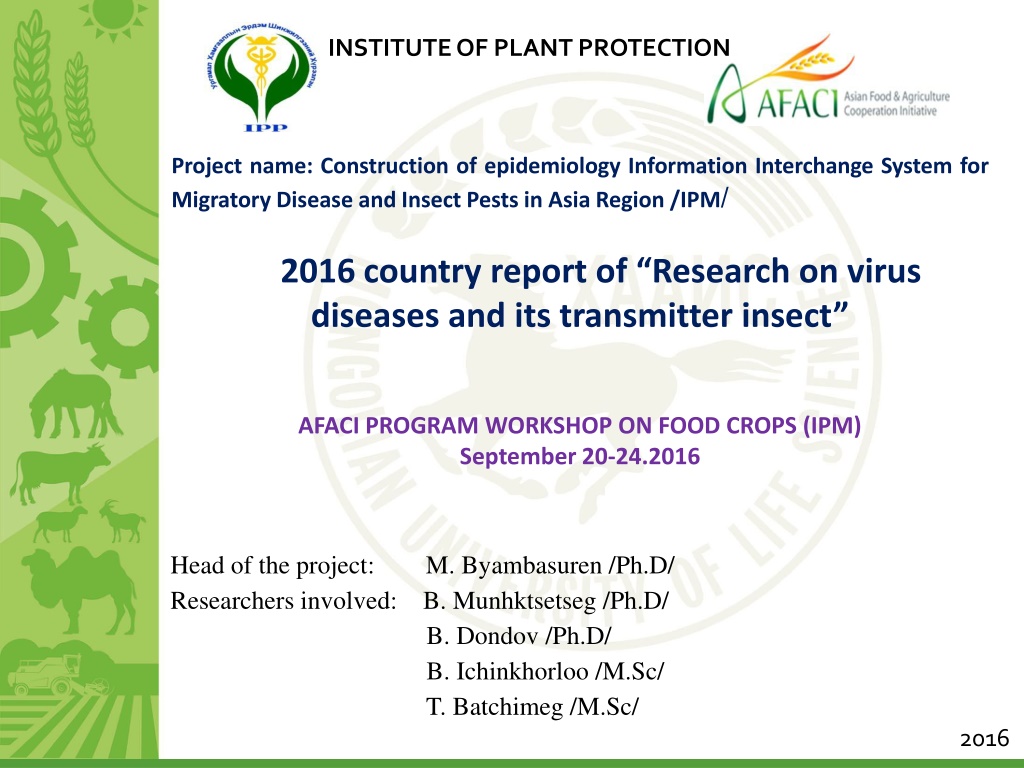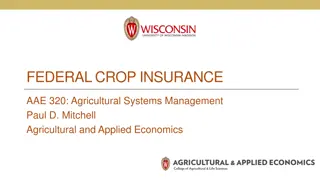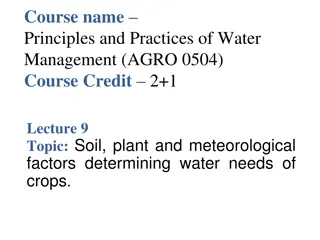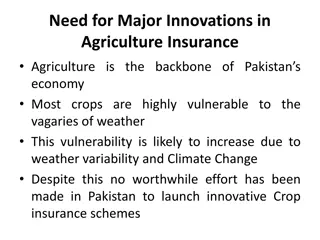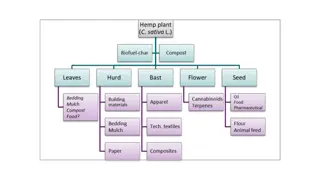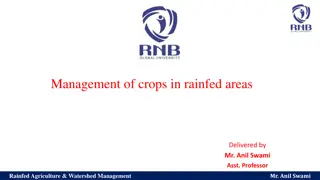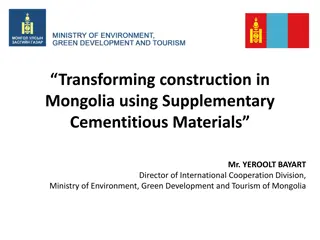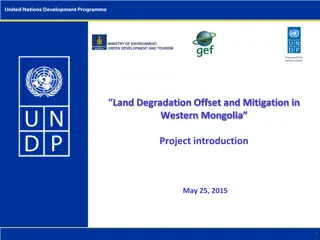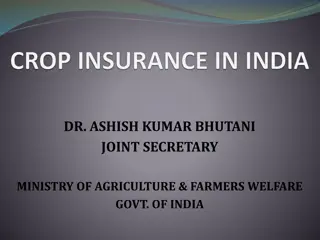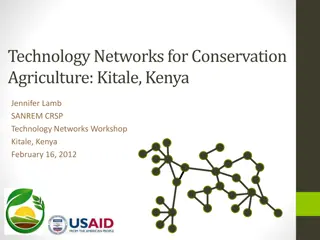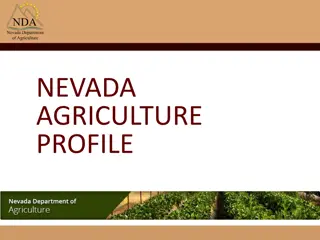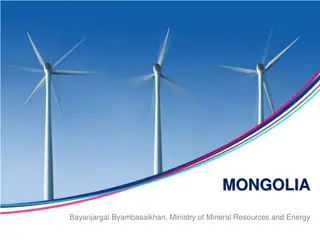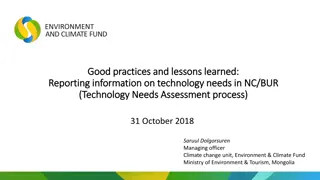Agriculture and Crop Production in Mongolia: A Comprehensive Overview
Mongolia's agricultural landscape, focused on livestock until 1959, has evolved to include crop production industries aimed at meeting domestic demand and increasing output. With three cultivation campaigns implemented by the government, a diverse range of crops is cultivated by thousands of farmers and entities. This report delves into the unique challenges and opportunities presented by Mongolia's distinctive climate and agricultural practices.
Download Presentation

Please find below an Image/Link to download the presentation.
The content on the website is provided AS IS for your information and personal use only. It may not be sold, licensed, or shared on other websites without obtaining consent from the author. Download presentation by click this link. If you encounter any issues during the download, it is possible that the publisher has removed the file from their server.
E N D
Presentation Transcript
INSTITUTE OF PLANT PROTECTION . Project name: Construction of epidemiology Information Interchange System for Migratory Disease and Insect Pests in Asia Region /IPM/ 2016 country report of Research on virus diseases and its transmitter insect AFACI PROGRAM WORKSHOP ON FOOD CROPS (IPM) September 20-24.2016 Head of the project: Researchers involved: B. Munhktsetseg /Ph.D/ B. Dondov /Ph.D/ B. Ichinkhorloo /M.Sc/ T. Batchimeg /M.Sc/ M. Byambasuren /Ph.D/ 2016
Introduction -Background Agriculture of Mongolia 2016 Result of project 2017 Project plan
Brief Introduction of Mongolia It borders Russia to the north and China to the south.
Area: At 1,564,116 square kilometers, Mongolia is the world's nineteenth-largest country. Population: 3.2 million /90% of population ethnic Mongolian ~ other 10% made up of Kazakh, Russian, Chinese and other/ Political system: a parliamentary republic Capital name: Ulaanbaatar
THE CLIMATE Mongolia naturally have 4 seasons. The winter long with temperature but summer is hot and not so long. The average summer temperature is +20 to +400C and winter is - 200C to - 400C. Annual rainfall Frost free 200- 300mm,day 90-100 days is continues cold
Mongolia has been the country oriented only on livestock until 1959.
Crop production industry With the purpose of supplying domestic needs in wheat, potatoes and vegetable and increasing their production the Government of Mongolia has implemented three-stage cultivation campaigns: The first campaign in 1959, the second in 1976 and the third in 2008.
At present about 1200 entities, 34.5 thousand farmers or in total 65.0 thousand farmers, technicians and orchardists are running their activities. They plant wheat, barley, corn, rye buckwheat, soy, popcorn, rapeseed, potatoes, sea buckthorn and 30 types of other vegetables.
Greenhouse cropping has successfully been developing over the last year. The total area of the greenhouse planting has reached 68.4 thousand hectares. Out of them winter greenhouses have 17.5 hectares and summer greenhouse 50.9 hectares.
The crop production industry oriented on private property has rapidly developed. Crop working area has reached 769 thousand hectares that succeeded to fully supply the domestic needs of wheat and potatoes and up to 57 per cent of the vegetable.
Table-1 Crop production Year Wheat Yield thous ton Potato Yield thous ton Vegetables Yield thous ton Sown area thous ha 293.2 306.3 291.9 312.6 215.7 Unit yield t/ha Sown area thous ha 14.9 16.2 15.1 13.3 12.7 Unit yield t/ha Sown area thous ha 7.6 7.1 8.1 8.3 6.8 Unit yield t/ha 2011 2012 2013 2014 2015 448.1 476.1 386.7 518.7 389.6 1.53 1.55 1.32 1.66 1.02 199.2 242.8 190.0 163.1 165.1 13.37 14.99 12.58 12.26 11.12 105.2 98.4 101.8 102.5 72.4 13.84 13.86 12.57 12.35 13.40 Data source:Mongolian statistic publication
Places conducted the study: Bayangol research and production center of IPP, Bornuur soum , Tuv province. (480 37 50.458 N 1060 19 48.447 E) Nart training and production center of MULS, Bornuur soum, Tuv province. (480 40 47.971 N1060 16 24.137 E) Kangwon greenhouse, Bornuur soum, Tuv province 400m2 (480 29 18.670 N 1060 16 40.560 E) Laboratory: 1. Entomology of laboratory. Institute of plant protection 2. Plant phatology of laboratory. Institute of plant protection Studied crop plants: wheat, potato, cucumber Study objects: insects belonging to Aphididae, Cicadellidae, Lygaedae family, fungal disese, bacterial disease and virus disease
2016 result of project 1. Stationary study site 1. Progress on study conducted in Nart training and production center of MULS, Bornuur soum, Tuv province. 1.1. Results on prevalence and density of insects in wheat field. /by survey net 100 sweeps/ Pest insects Enemias insects Number of insects in 1m2 field Ambrostoma quadiimpressum 3 Plant development stage Trigonotylus caelestialium K 3 Psammotetettix aliemus W 54 Epicauta metalocephala G - Eurygaster testudinaria G - Chuetocnema hortensis D - Deraecoris punctulatus F 2 Notoxusap pendicinus D - Dolycoris penicillatus H - Polymerus cognatus L - Chlorops pumilionis B - Phylloteta undulate K 2 Phyllotreta nigripes F - Date Eurydema geblery K 2 Epicauta sibirica P - Altica sajanica M - Lygus Hesperus F 4 Hymenoptera 1 Coccinellspp - Chrysopspp 4 Cassidaspp - All insects 75 Total 70 Total 5 M VI.25 Tillering 00.8 % 4 5.3 2.6 - 2.6 - - 72.2 - - 4 2.6 - - - - - 93.3 5.3 - 1.4 - 6.7 100 VII.5 Shooting 16 8 12 10 2 - - 66 1 - 2 3 17 1 - - - 138 5 - 1 - 6 144 1.16 % 11.1 5.5 8.3 7 1.4 - - 45.8 0.7 - 1.4 2.1 11.8 0.7 - - - 95.8 3.5 - 0.7 - 4.2 100 VII.25 Heading 102 93 47 74 - - - 164 7 - - - - 10 - - 6 503 15 2 6 1 24 527 0.58 % 19.3 17.9 8.9 14 - - - 31.1 4.9 - - - - 1.9 - - 1.1 95.4 2.8 0.4 1.1 0.3 4.6 100 VIII.5 Flowering 17 97 27 22 - - - 72 15 1 2 - 43 1 - - - 297 19 7 3 - 29 326 0.36 % 5.2 29.8 6.7 6.7 - - - 22.1 4.6 0.3 0.6 - 13.2 0.3 - - - 91.1 5.8 2.1 1 - 8.9 100 VIII.15 Repenin and milky stege 93 5 2 13 - 4 4 178 - - 1 46 - - 12 2 1 361 17 14 15 1 47 408 0.44 % 22.8 1.2 0.5 3.2 - 1 1 43.6 - - 0.2 11.3 - - 3 0.5 0.2 88.5 4.2 3.4 3.7 0.2 11.5 100
Ratio of collected insect order using survey net (by population numbers) Based on the data shown on above graph insect prevalence is dependent upon wheat growth stages. There were total of 21 species of insects belonging to 6 orders have distributed which 19 percent were natural enemies and rest 81 percent were insect pests. At primary stage insect density was at lowest while in last growth stage density was at caelestialium, Psammatettix aliemus species were most dominant. Graph.1 Notoxus appendicinus D enemias insects Hymenoptera Coccinella spp Chrysopa spp Chlorop spumilionis B Altica sajanica M Phyllotreta nigripes F highest. AlsoTrigonotylus Chuetocnema hortensis D Cassida spp Phylloteta undulata K Ambrostoma quadiimpressum M Pest insects Epycauta sibirica P Repenin and milky stege Epicauta metalocephala G Flowering Psammotetettix aliemus W Dolycoris penicillatus H Heading Eurygaster testudinaria G Eurydema geblery K Shooting Polymerus cognatus L Tillering Deraecoris punctulatus F Lygus Hesperus F Trigonotylus caelestialium K 0 20 40 60 80 100 120 140 160 180
Most dominant insect ratio /by survey net 100 sweeps/ Graph.2 200 180 178 164 160 140 120 102 100 93 80 72 66 60 54 40 20 17 16 3 0 Tillering Shooting Heading Flowering Repenin and milky stege Based on the above graph Psammatettix aliemus and Trigonotylus caelestialium species of insect density increased during last growth stages. fig.1:Psammatettix aliemus photo by: Ichinhorloo.B . Nart Bornuur soum, Tov province .2016 fig.2: Trigonotylus caelestialium photo by: Ichinhorloo.B . Nart Bornuur soum, Tov province .2016
1.2. Calculation on yellow sticky trap Table-3 Total mortality of insect trapped in yellow sticky trap used twice from 25th June until 15th of August, diagonally and in straight lines. Pest insects Enemias insects Trigonotylus caelestialium Epicauta megalocephala Psammatettix aliemus W Phyllotreta undulate K Polymerus cognatus L Chlorops pumilionis B Phyllotreta nigripes F Epicaua sibirica P Altica sajanica M Lygus herperus F Date Renewal Coccinellas pp Hymenoptera Chrysopa spp Orthoptera G K Total VI.25- VII.20 28 227 1 46 59 30 15 5 65 63 30 70 12 6 657 1 VII.20- VIII.15 74 319 - 52 68 27 6 - 168 95 58 91 43 18 1019 2 102 546 1 98 127 57 21 5 233 158 88 161 55 24 1676 All 6.1 32.6 0.1 5.8 7.6 3.4 1.2 0.3 14 9.4 5.2 9.6 3.3 1.4 100 % During plant growth stage yellow sticky traps were replaced twice. As a results 32.6% of the total insects collected were belonging to Diptera order.
Fig.3: Placement of yellow sticky trap in wheat field photo by: Ichinhorloo.B .Nart Bornuur soum, Tov province .2016 1.3. Method on study sites. Table-4 Calculation of wheat field study sites Date Plant developmen t stage Pest insects Total of The number of plants The number of points Haplothrips tritici K Alia sajanca Csiki., Lygus hespenus F Sitobion avenae F megalocephala G number damaged plants Psammotettix caelestialus K Trigonotylus Phyllotreta undulata K aliemus W Epicauta Renewal The VI.25 Tillering 1 2 1 2 1 2 1 2 10 10 10 10 10 10 10 10 439 495 441 470 462 414 402 411 61 68 83 92 163 121 155 178 1 1 - 1 1 2 - 1 - - - 1 - - 1 - - 1 - 2 1 1 3 2 1 - 2 2 9 6 7 5 - 1 4 1 11 10 9 6 2 3 6 4 27 15 14 10 - - - - 6 4 3 4 - - - - 1 - - 1 4 6 12 11 56 44 37 29 VII.5 Shooting VII.25 Heading VIII.5 Flowering
Throughout the all 4 growth stages of wheat Trigonotylus caelestialus K, Psammotettix aliemus W species of insects were most dominant. Insect damage to crops are determined using pagonometer method by picking 10sites and repeated it twice. Fig.4: Wheat leaf damage photo by: Ichinhorloo.B . Nart Bornuur soum, Tov province .2016
2. Stationary site 2. Study progress on potato planted field of Bayangol production center located at Bornuur soum, Tuv province. 2.1. Results of insect density on potatoes using survey net Table-5 Insect density of potato planted field at Bayangol production center Number of insects Date Plant development stage Pest insets Total Epicauta sibirica P megalocephala G Lygus hespenus F quodressum M Psammotettix Ambrostoma in1m2field Cassida spp Pentatoma Phyllotreta striatus L nigripes F Epicauta rufipes L VI.10 Establishment - - - - - - - - - - VI.27 Stolon initiation 3 1 1 3 - 6 - 8 22 0.02 VII.7 Tuber initiation 57 1 11 - - 4 14 36 123 0.14 VII.27 Tuber filling 15 4 3 1 - 5 5 48 81 0.09 VIII.7 Maturity 2 7 7 2 5 10 4 24 61 0.07
Insect order ratio /survey net 100 sweeps by population number/ Graph. 3 60 50 40 30 20 10 0 Establishment Stolon initiation Tuber initiation Tuber filling Maturity Based on the data given on above graph, insect prevalence differs depending on crop growth stages. There are total of 8 species of insects belonging to 3 orders were at highest at flowering stage and lowest at primary stages of plant growth. Also Epicauta megalocephala G and Psammatettix striatus L species of insects were most dominant.
2.2. Calcualtion of yellow sticky trap We have calculated total mortality of insect trapped in yellow sticky trap used twice from 28th June until 2nd of August, diagonally and in straight lines. Table-6 Calculation of yellow sticky trap Pest insects Ambrostoma quodressum Epicauta megalocephalaG Deraeocoris punctulatus F Psammatettix striatus L Phyllotreta undulate K Polymerus cognatus F Phyllotreta nigripes F Epicaua sibirica P Lygus herpenus F Date Renewal Total M 210 48 5 7 9 8 2 12 2 303 VI.28-VII.23 1 198 36 12 9 8 11 1 11 3 289 VII.23-VIII.18 2 408 84 17 16 17 19 3 23 5 592 All 68.9 14.2 2.9 2.7 2.9 3.2 0.5 3.9 0.8 100 % According to our study, 68.9% out of total insects were belonging to Dipteran order.
Fig.5: Placement of yellow sticky traps in potato field photo by : Ichinhorloo.B . bayangol Bornuur soum, Tov province .2016 Fig.7: Psammatettix striatus L photo by : Ichinhorloo.B .Enthomology of laboratory. EScope .2016 Fig.6: Epicauta megalocephala G photo by : Ichinhorloo.B . bayangol Bornuur soum, Tov province .2016
3. Stationary study site 3.Study progress of Kangwon state cucumber planted greenhouse located at Bornuur soum of Tuv province. 3.1. We placed 30 pieces of yellow sticky traps in parallel locations for twice and haven t found any insects stcked to it. Therefore, we have picked 100 leaves and repeatedly checked to see if any insects can be found and kept a record Table-7 Calcualtion of insects distributed in greenhouse Leaf number Pest insects Total Thrips tabaci L % Myzodes persicae S % Date Renewal VI.30 1 100 94 - 94 2 100 81 - 81 VII.10 1 100 3 - 3 2 100 1 - 1 VII.30 1 100 - - - 2 100 - - - VIII.10 1 100 - 87 87 2 100 - 91 91 On 30th of June, 81-94 percent of the 100 leaves were infected with thrips. After insecticide application the percent dropped down to 1-3% on 10th of July. When we repeadetly checked on 30th of July no insect pests were found. Whereas, on 10th of August 87-91 percent were infected with flea.
Fig.7: Thrips tabaci LAdult, Nymph photo by : Ichinhorloo.B .Enthomology of laboratory. EScope .2016 Fig.8: Myzodes persicae S photo by : Ichinhorloo.B .Enthomology of laboratory. EScope .2016
2.1. Virus disease study of wheat : Variety: Altaiskay Host crop: wheat Soil: brown soil dominant in Agricultural region Table-8:Disease development and prevalence of wheat crop % .2016 Number of plants used for calculation Number of infected plants Disease develop ment, % Variation /by growth stage/ Prevalenc e, % Recorded diseases Date - VI/25 Tillering - 100 - - Shooting - VII/5 - 100 - - 13 Puccinia tritici 100 9 9.0 VII/25 Heading 5.6 Septoria tritici 100 11 11.0 22.3 Puccinia tritici 100 21 21.0 VIII/5 Flowering 27.4 Septoria tritici 100 17 17.0 On wheat crop 2 species of fungal diseases found. Starting from second 10 days of July, diseases become appearant on wheat crops.
b c d a Fig 9 a.Puccinia tritici, b.Septoria tritici of head c.Septoria tritici of leaf d. General view of study field. photo by: Batchimeg.T . Nart Bornuur soum, Tov province .2016
2.2. Virus disease study on potato field: Variety: Gala Host crop: Chemical fallow Soil: brown soil dominant in Agricultural region Table-9 Disease development and prevalence found in potato % /2016 Variation /by growth stage/ Number of infected plants Disease develop ment, % 2.5 4.8 4.5 - - - 13.4 6.0 23.0 12.0 20.6 25.0 23.0 23.7 Number of plants used for calculation Prevale nce, % Date Recorded diseases Establishment Fusarium solani 6 11 9 - - - 19 6.0 23.0 12 17 31 28 35 3.0 5.5 9 - - - 19 6.0 23.0 12.0 17.0 31.0 28.0 35.0 Rhizoctonia solani Kuhn Erwinia carotovora Virus disease Alternaria solani Phytophthora infestans Virus disease Alternaria solani Virus disease Phytophthora infestans Alternaria solani Virus disease Phytophthora infestans Alternaria solani V/1 200 Stolon initiation 100 100 100 100 100 100 100 100 100 100 100 VI/10 Tuber initiation Tuber filling VI/27 VII/7 Budding VIII/7
At our study site 1 bacterial, 1 virus and 2 species of fungal disease found on potatos during plant growth period. Starting from 3rd ten days of July or budding stage disease development and prevalence were at highest. Graph. 4 Potato of disease prevalence,% 70 63 60 50 40 31 29 30 23 19 18 17.5 20 9 6 6 10 0 0 0 0 0 0 Establishment Stolon initiation Tuber initiation flowering stage budding fungal 17.5 0 6 29 63 bacter 9 0 0 6 18 virus 0 0 19 23 31 Date fungal bacter virus Tuber initiation virus disease account for 19.0% and fungal disease account for 6.0% while at flowering stage virus disease increased to 23.0%, fungal disease remained the same and virus disease 23.0%. During the budding stage starting from first 10 days of August disease prevalence was at highest with 31.0% virus, 18.0% bacterial and 63.0% fungal disease.
a b d b Fig 10 a.General view of study field b. virus disease c. virus disease d. early blight . photo by: Batchimeg.T . Bayangol Bornuur soum, Tov province .2016
2.3. Virus disease study cucumber in greenhouse Variety: Pigdadi Host crop: cucumber Soil: brown soil dominant in Agricultural region Table-10 Disease development and prevalence of cucumber % /2016/ Number of plants used for calculation - 225 225 225 225 225 225 225 225 225 Number of infected plants Variation Prevalenc e, % Disease developm ent, % - 3.4 4.8 7.0 4 10.0 13.0 11.1 14.2 12.5 Date Recorded diseases / by growth stages / V/30 Germinating stage - - - Pseudomonas syrangae pv Virus disease Pseudomonas syrangae pv Colletotrichum orbiculare virus Pseudomonas syringae pv Colletotrichum orbiculare Virus disease Sphaerotheca fuliginea 12 21 33 17 28 54 37 36 18 5.3 9.3 14.6 7.5 12.4 24 16.4 16.0 VII/10 Tiller VII/30 flowering stage VIII/10 Fruit stage 8.0 At our study site 1 bacterial, 1 viral and 2 species of fungal disease found on potatos during plant growth period. Starting from 3rd ten days of July or budding stage disease development and prevalence were at highest.
Graph. 5 Disease prevalence of cucumber, % 30 24.4 24 25 20 16 14.6 15 12.4 9.3 10 7.5 5.3 5 0 0 0 0 0 Germinating stage Tiller flowering stage Fruit stage fungal 0 0 7.5 24.4 bacter 0 5.3 14.6 16 virus 0 9.3 12.4 24 At primary growth stages, virus disease account for 9.3% and bacterial disease was 5.3% whereas at flowering stage or in harvesting period disease prevalence was at highest with 24.0% of virus, 16.0% of bacterial and 24.4% of fungal diseases.
d b c Fig 11 . general scheme of study field,bVirusdisease c.Pseudomonas syrangae d.Sphaerotheca fuliginea. photo by: Batchimeg.T .Bornuur soum, Tov province .2016
Conclusion The first study site is located at Nart center for training and production in Bornuur soum of Tuv province. Various methods to collecting and identifying insect pest distributed in the study site which involves collectingnet, yellow sticky trap and pagonometer methods. As a result, 17 species of insects belonging to 6 orders have recorded and out of these insects Psammatettixstriatus L and Trigonotylus caelestialus K species were dominantly distributed. In wheat field, 2 species of fungal diseases are found and disease prevalence was increased to 17-21% starting from second 10 days of July . 1. Second study site is located at Bayangol center for experiment production in Bornuur soum of Tuv province. In potato planted field, 11 species of insects belonging to 3 order were found using collecting net and yellow sticky traps. Based on our study results Epicautamegalocephala G and Psammatettixstriatus L species were dominantly distributed. Starting from first 10 days of August, disease prevalence was at highest showing 31.0% viral, 18.0% bacterial and 63.0% fungal diseases reported. 1. Third study site is located at Gangwon state greenhouse located in Bornuur soum of Tuv province. At this site, no insects were trapped with yellow sticky paper thus we have picked 100 leaves to manually determine the insect distribution and repeated it twice. As a result, 81-94 percent of the leaves were infected with Trialeurodesvaporariorum W by 30th of June. Thus we have applied insecticide. On second diagnostics, 87-91 percdent were infected with Myzodespersicae S by 10th of July. During harvesting period, disease prevalence was at highest showing 16.0% viral, 24.0% bacterial and 24.4% fungal disease were apparent. 1.
Note: Study will be continued and final results will be available on November
Discussion and suggestions Continue and strengthen the monitoring works for pest insects and virus disease /wheat, cucumber, potato/ Continue strong collaboration that is very essential for the improved management of pest insect and plant dieases in the region Conventional and molecular approaches need to be strengthened for sustainable control of pest insects and virus and fungi bacter disease we would like to attend to short-term for pest insects and virus diseases seminar For example:/ korea, thailand etc.,/
2017 Project plan Field occurrence information of wheat, potato and cucumber pest insects and plant disease/virus/ species secured Continue field monitoring data of wheat, cucumber and potato / light traps, stick trap, and field collection/ collected and analyzed. The training on field surveys and data management would be carried out Continue to survey more provinces for wheat, potato, and vegetable pest insects and virus infection plant
Researchers involved in this project Category Name Organizatoin Title Degree Year email 1 Director Byambasuren.M Institute of Plant Protection Ecologist Ph.D 15 Byamba0730@yahoo.com 2 Head Entomology laboratory of Munkhtsetseg.B Institute of Plant Protection Biologist Ph.D 23 Muugi_9@yahoo.com 3 Head Pathology laboratory of Dondov.B Institute of Plant Protection Plant protection Ph.D 23 Dogiibud@yahoo.com 4 Researcher Batchimeg.T Institute of Plant Protection Plant protection M.Sc 4 Chimmi_j@yahoo.com 5 Researcher Ichinkhorloo.B Institute of Plant Protection Plant protection M.Sc 6 b.ichiko86@gmail.com
